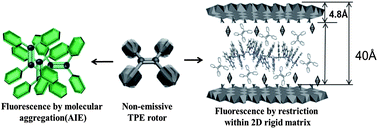Two dimensional restriction-induced luminescence of tetraphenyl ethylene within the layered double hydroxide ultrathin films and its fluorescence resonance energy transfer†
Abstract
Neutral poly(vinyl carbazole) (PVK) and

* Corresponding authors
a
State Key Laboratory of Chemical Technology, Beijing University of Chemical Technology, P. Box 98 Beisanhuan East Road 15, Beijing, P. R. China
E-mail:
lujun@mail.buct.cn
Fax: +86 1064425385
Tel: +86 1064412131
Neutral poly(vinyl carbazole) (PVK) and

 Please wait while we load your content...
Something went wrong. Try again?
Please wait while we load your content...
Something went wrong. Try again?
Z. Li, J. Lu, Y. Qin, S. Li and S. Qin, J. Mater. Chem. C, 2013, 1, 5944 DOI: 10.1039/C3TC31164C
To request permission to reproduce material from this article, please go to the Copyright Clearance Center request page.
If you are an author contributing to an RSC publication, you do not need to request permission provided correct acknowledgement is given.
If you are the author of this article, you do not need to request permission to reproduce figures and diagrams provided correct acknowledgement is given. If you want to reproduce the whole article in a third-party publication (excluding your thesis/dissertation for which permission is not required) please go to the Copyright Clearance Center request page.
Read more about how to correctly acknowledge RSC content.
 Fetching data from CrossRef.
Fetching data from CrossRef.
This may take some time to load.
Loading related content
